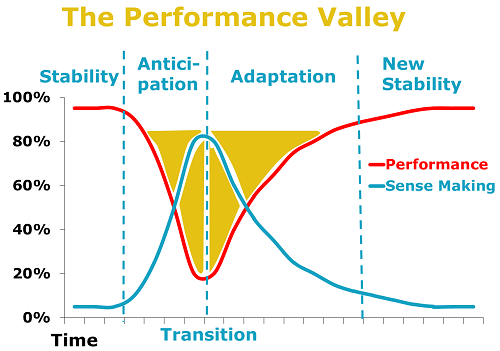When you walk in the room, who shows up for Read more →
Listening in the Performance Valley
Posted Monday, May 19, 2014Listening is a key skill for leaders. Leaders who listen well are more effective, more persuasive and more engaging than leaders who don’t listen.
Listening is especially useful when the other person is trying to make sense of change. Anticipating and adapting to change requires substantial cognitive effort – what I call sense-making. Sense-making creates a performance valley during change.
A leader who effectively listens can accelerate the other person’s sense-making. That gets them out of the performance valley quicker.
Listening requires you to be quiet and focus on the other person. Carol Wilson¹ lays out five levels of listening:
1. Interrupting
2. Sharing
3. Advising
4. Attentive Listening
5. Active Listening
For levels 1,2 and 3, you’re not listening if you’re interrupting, sharing or advising. Attentive listening and active listening are both ways to truly listen. Today, let’s look at Level 4 – attentive listening.
4. Attentive Listening
“I had the worst meeting with my boss today.”
“What happened?”
“She tore apart my financial report. I was embarrassed in front of everyone.”
“Who else was there?”
. . .
“What did your boss say about the report?”
With attentive listening, you focus on the other person and what they say. You notice their words and ask on-target questions. You help the other person pull their thoughts together. As Karl Weick says “How can I know what I think until I see what I say?” Attentive listening keeps them talking, helping them to know what they think with more breadth and clarity.
So, how can you listen attentively?
- Focus on the facts of the situation. An attentive listener asks “Who? What? Where? When?”
- Pause. Attentive listening requires you to focus on the words of the other person. Go slow enough to truly listen. Don’t plan your next question while the other person is talking. Listen to what they say, then compose your question.
- Allow the other person to pause also. If they are silent after you ask a question, be patient and allow them to think.
With attentive practice, you can become a powerful listener. And, if you listen carefully, you may notice a few performance valleys shrinking.
______________________
¹Carol Wilson, “Tools of the Trade” Training Journal, July, 2010, pp. 65-66.


